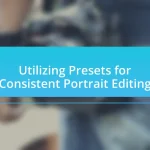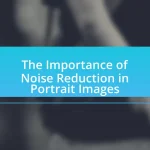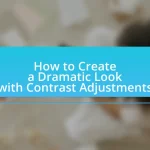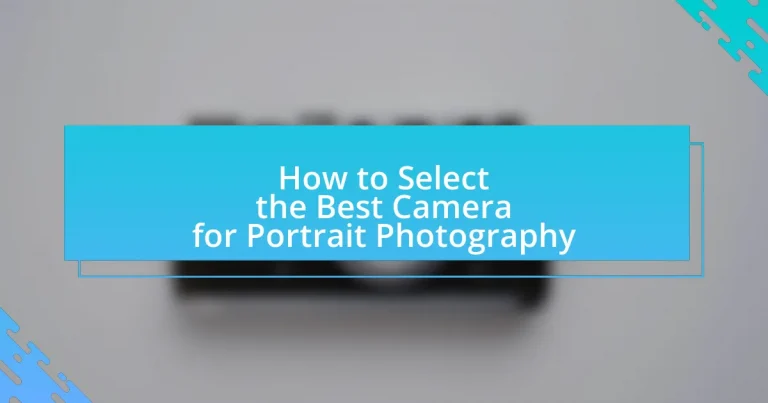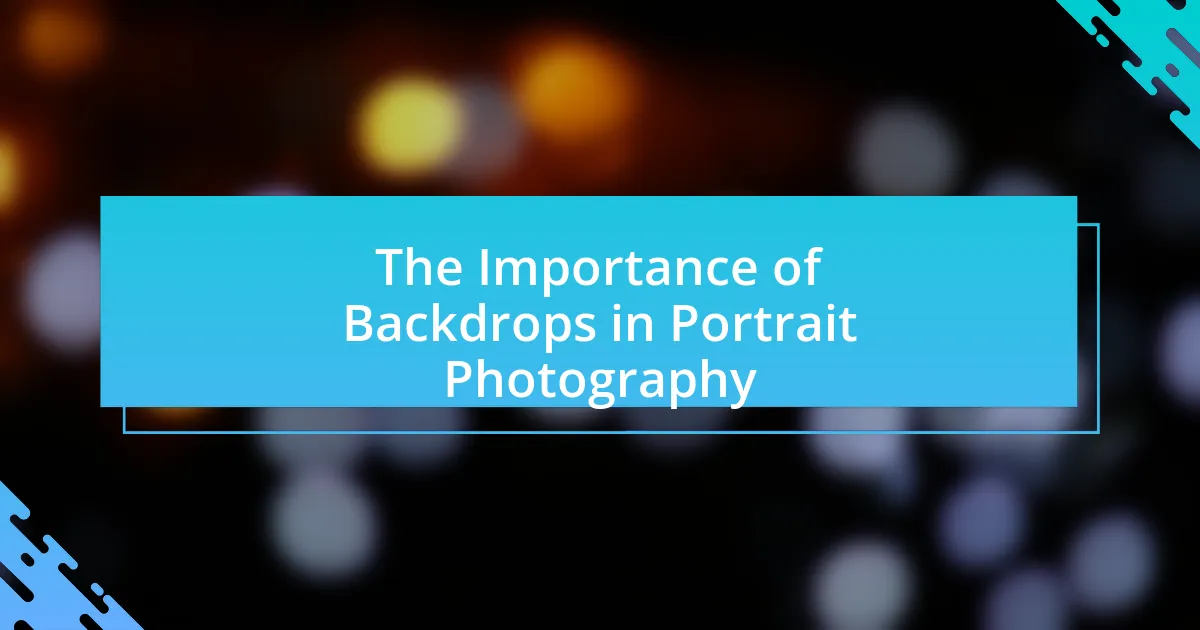Selecting the best camera for portrait photography involves considering several critical factors, including sensor size, lens compatibility, and autofocus capabilities. Larger sensors, particularly full-frame models, enhance image quality and low-light performance, while prime lenses with wide apertures allow for better depth of field control and subject isolation. Fast and accurate autofocus systems are essential for capturing sharp images of subjects’ features. This article provides a comprehensive guide on the specifications and features to prioritize when choosing a camera for portrait photography, including the impact of sensor size, lens choice, and ergonomics on the overall shooting experience.

What Should You Consider When Selecting a Camera for Portrait Photography?
When selecting a camera for portrait photography, consider the sensor size, lens compatibility, and autofocus capabilities. A larger sensor, such as full-frame, captures more detail and performs better in low light, which is crucial for achieving high-quality portraits. Additionally, the ability to use a variety of lenses, particularly prime lenses with wide apertures, allows for better control over depth of field and bokeh effects, enhancing the subject’s isolation from the background. Lastly, a camera with fast and accurate autofocus ensures that the subject’s features are sharp, which is essential for portrait work.
How does sensor size impact portrait photography?
Sensor size significantly impacts portrait photography by influencing depth of field, image quality, and low-light performance. Larger sensors, such as full-frame sensors, provide a shallower depth of field, allowing for more pronounced background blur, which enhances subject isolation in portraits. This effect is crucial for creating aesthetically pleasing images where the subject stands out against a soft background. Additionally, larger sensors typically capture more light, resulting in better image quality with less noise, especially in low-light conditions. For instance, full-frame sensors can produce cleaner images at higher ISO settings compared to crop sensors, making them preferable for portrait photography in various lighting environments.
What are the differences between full-frame and crop sensors?
Full-frame sensors are larger than crop sensors, measuring approximately 36mm x 24mm, while crop sensors, often referred to as APS-C, typically measure around 22mm x 15mm. This size difference affects several key aspects of photography. Full-frame sensors capture more light, resulting in better low-light performance and dynamic range, which is crucial for portrait photography. Additionally, full-frame sensors provide a wider field of view, allowing for more creative framing options. In contrast, crop sensors have a crop factor of about 1.5x, which effectively narrows the field of view and can make lenses appear longer, impacting composition. These differences are significant for photographers when selecting equipment for portrait work, as the sensor size directly influences image quality and versatility.
How does sensor size affect depth of field in portraits?
Sensor size significantly affects depth of field in portraits, with larger sensors producing a shallower depth of field compared to smaller sensors. This occurs because larger sensors capture more light and allow for wider apertures, which in turn creates a more pronounced background blur, isolating the subject effectively. For example, a full-frame sensor can achieve a shallower depth of field at the same aperture compared to an APS-C sensor, making it easier to achieve that desirable bokeh effect in portrait photography. This characteristic is crucial for portrait photographers aiming to emphasize their subjects against a softly blurred background.
What role does lens choice play in portrait photography?
Lens choice is crucial in portrait photography as it directly influences the composition, depth of field, and overall aesthetic of the image. A lens with a longer focal length, such as an 85mm or 135mm, allows for flattering compression of facial features and creates a pleasing background blur, known as bokeh, which isolates the subject. Conversely, a wide-angle lens can distort facial features and is generally less flattering for portraits. Additionally, lenses with wider apertures, like f/1.8 or f/1.4, enable photographers to achieve a shallow depth of field, enhancing subject separation from the background. This technical understanding is supported by the fact that many professional portrait photographers prefer prime lenses for their sharpness and ability to create a specific look, as evidenced by the popularity of the 85mm f/1.4 lens in portrait work.
Which focal lengths are best for portrait photography?
The best focal lengths for portrait photography are typically between 85mm and 135mm. These focal lengths provide a flattering perspective, allowing for good subject isolation and minimal distortion. For instance, an 85mm lens is often favored for head-and-shoulders portraits, while a 135mm lens is ideal for full-body shots, as it allows the photographer to maintain a comfortable distance from the subject while still achieving a pleasing composition. This range is supported by the fact that lenses within this focal length range create a natural look, enhancing facial features without exaggeration.
How do prime lenses compare to zoom lenses for portraits?
Prime lenses generally offer superior image quality and wider apertures compared to zoom lenses for portrait photography. The fixed focal length of prime lenses allows for better sharpness, contrast, and less distortion, which is crucial for capturing fine details in portraits. Additionally, prime lenses often have larger maximum apertures, such as f/1.8 or f/1.4, enabling better low-light performance and creating a shallower depth of field for more pronounced background blur, enhancing subject isolation. In contrast, zoom lenses provide versatility with multiple focal lengths but may compromise on image quality and maximum aperture size, making them less ideal for achieving the same level of artistic effect in portraiture.
Why is image quality important in portrait photography?
Image quality is crucial in portrait photography because it directly affects the clarity and detail of the subject’s features. High image quality allows for accurate representation of skin tones, textures, and expressions, which are essential for capturing the subject’s personality and emotions. Studies show that images with higher resolution and better dynamic range result in more visually appealing portraits, as they enhance the viewer’s connection to the subject. For instance, a survey by the American Society of Media Photographers indicates that 70% of clients prefer portraits that showcase fine details and vibrant colors, underscoring the importance of image quality in achieving professional results.
What specifications should you look for to ensure high image quality?
To ensure high image quality in portrait photography, look for a camera with a high resolution sensor, ideally 20 megapixels or more. A higher megapixel count allows for greater detail and clarity in images, which is crucial for capturing the nuances of skin tones and textures in portraits. Additionally, consider a camera with a wide dynamic range, which enables it to capture details in both highlights and shadows, enhancing the overall image quality. A good lens with a wide aperture (f/1.8 or lower) is also essential, as it allows for better low-light performance and creates a pleasing depth of field, isolating the subject from the background. These specifications collectively contribute to producing sharp, vibrant, and professional-quality portraits.
How does low-light performance affect portrait photography?
Low-light performance significantly impacts portrait photography by determining the camera’s ability to capture clear, detailed images in dimly lit environments. Cameras with superior low-light performance, characterized by larger sensors and wider apertures, can produce images with less noise and better color accuracy, essential for flattering skin tones in portraits. For instance, a camera with a full-frame sensor can handle higher ISO settings effectively, allowing photographers to shoot in lower light without sacrificing image quality. This capability is crucial for portrait photographers who often work in varied lighting conditions, such as indoor settings or during twilight.

What Features Should You Look for in a Portrait Photography Camera?
When selecting a portrait photography camera, prioritize features such as a large sensor, fast autofocus, and high-quality lens options. A large sensor, like a full-frame sensor, captures more light and detail, resulting in better image quality and depth of field control, which is essential for isolating subjects. Fast autofocus systems ensure sharp focus on the subject’s eyes, critical for portraiture. Additionally, high-quality lens options, particularly those with wide apertures (like f/1.8 or f/2.8), allow for beautiful background blur (bokeh) and enhanced subject separation. These features collectively enhance the overall portrait photography experience, making it easier to achieve professional results.
How does autofocus performance influence portrait photography?
Autofocus performance significantly influences portrait photography by determining the accuracy and speed at which a camera can focus on a subject’s face or eyes. High-performance autofocus systems, such as those with phase detection and eye-tracking capabilities, enable photographers to capture sharp images even in dynamic or low-light conditions. For instance, cameras with advanced autofocus can achieve focus in as little as 0.02 seconds, which is crucial for capturing fleeting expressions or moments in portraiture. This precision reduces the likelihood of missed shots and enhances the overall quality of the portraits, as sharp focus on the subject’s eyes is often essential for impactful imagery.
What types of autofocus systems are best for capturing portraits?
The best types of autofocus systems for capturing portraits are phase-detection autofocus and hybrid autofocus systems. Phase-detection autofocus is known for its speed and accuracy, making it ideal for quickly locking onto a subject’s face, which is crucial in portrait photography. Hybrid autofocus systems combine phase-detection and contrast-detection, providing versatility and improved performance in various lighting conditions. This combination allows for precise focusing on the subject’s eyes, which is essential for achieving sharp and engaging portraits.
How important is face detection in autofocus systems?
Face detection is crucial in autofocus systems, particularly for portrait photography, as it enhances the accuracy of focus on subjects’ faces. This technology allows cameras to identify and prioritize human faces, ensuring that they are sharp and well-defined in images. Studies have shown that cameras equipped with advanced face detection autofocus systems significantly improve the likelihood of capturing well-focused portraits, as they can quickly adjust focus in dynamic environments where subjects may move. For instance, a camera with face detection can achieve focus in less than a second, compared to traditional autofocus methods, which may struggle in similar conditions. This capability is essential for photographers aiming to capture expressive and detailed portraits, making face detection a vital feature in selecting the best camera for this genre.
What is the significance of burst rate in portrait photography?
The burst rate in portrait photography is significant because it determines how many frames a camera can capture in a second, which is crucial for capturing fleeting expressions and moments. A higher burst rate allows photographers to take multiple shots in quick succession, increasing the likelihood of obtaining the perfect shot where the subject’s expression is ideal. For instance, cameras with burst rates of 10 frames per second or higher are often preferred for portrait photography, as they provide more opportunities to capture dynamic poses and subtle facial changes, enhancing the overall quality of the portrait.
How does burst rate affect capturing candid moments in portraits?
Burst rate significantly enhances the ability to capture candid moments in portraits by allowing photographers to take multiple shots in quick succession. This rapid shooting capability increases the likelihood of capturing spontaneous expressions and movements that occur within a fleeting moment. For instance, a camera with a burst rate of 10 frames per second can capture a range of emotions and actions that a slower camera might miss, providing a greater selection of images to choose from. Studies in photography have shown that higher burst rates lead to a higher probability of obtaining the perfect shot during dynamic situations, making it a crucial feature for portrait photographers aiming to document authentic moments.
What is the ideal burst rate for portrait photographers?
The ideal burst rate for portrait photographers is typically between 3 to 5 frames per second (fps). This range allows photographers to capture expressions and moments without overwhelming the storage and processing capabilities of their equipment. A burst rate of 3 to 5 fps is sufficient to ensure that key moments are not missed, especially in dynamic settings, while still maintaining image quality and focus accuracy.
Why is ergonomics important when selecting a camera for portraits?
Ergonomics is important when selecting a camera for portraits because it directly affects the photographer’s comfort and efficiency during extended shooting sessions. A camera that fits well in the hand, has intuitive controls, and allows for easy adjustments can reduce fatigue and enhance focus on composition and lighting. Studies show that ergonomic design can lead to improved performance and satisfaction, as photographers are less likely to experience discomfort or strain, which can detract from the quality of their work. Therefore, choosing a camera with good ergonomics is essential for achieving optimal results in portrait photography.
How does camera weight and size affect shooting comfort?
Camera weight and size significantly impact shooting comfort by influencing the ease of handling and stability during use. Heavier cameras can lead to fatigue during extended shooting sessions, while larger cameras may be more cumbersome to maneuver, especially in dynamic environments. Research indicates that a camera weighing over 2 pounds can cause noticeable discomfort after prolonged use, affecting the photographer’s ability to maintain steady shots. Additionally, smaller and lighter cameras often allow for quicker adjustments and less strain on the photographer, enhancing overall shooting experience. Thus, selecting a camera with an appropriate weight and size is crucial for maximizing comfort during portrait photography.
What features enhance usability during portrait sessions?
Features that enhance usability during portrait sessions include a fast autofocus system, customizable controls, and a high-resolution LCD screen. A fast autofocus system allows photographers to quickly capture sharp images of subjects, which is crucial in dynamic portrait settings. Customizable controls enable photographers to adjust settings efficiently without navigating complex menus, streamlining the shooting process. A high-resolution LCD screen facilitates accurate framing and reviewing of images, ensuring that details are not missed. These features collectively improve the overall experience and effectiveness of capturing portraits.

How Can You Make the Best Choice for Your Portrait Photography Needs?
To make the best choice for your portrait photography needs, select a camera that offers high resolution, good low-light performance, and interchangeable lenses. High resolution, typically 20 megapixels or more, ensures detailed images, while good low-light performance allows for shooting in various environments without sacrificing quality. Interchangeable lenses provide versatility, enabling you to choose the right focal length for different portrait styles. Research indicates that cameras with larger sensors, such as full-frame models, significantly enhance image quality and depth of field, making them ideal for portrait photography.
What budget considerations should you keep in mind when selecting a camera?
When selecting a camera, budget considerations include the initial purchase price, ongoing costs for lenses and accessories, and potential future upgrades. The initial purchase price varies significantly based on camera type; for instance, DSLRs and mirrorless cameras can range from a few hundred to several thousand dollars. Ongoing costs, such as high-quality lenses, memory cards, and protective gear, can add hundreds to thousands of dollars to the overall budget. Additionally, considering future upgrades is crucial, as investing in a camera system with compatible lenses and accessories can save money in the long run. According to a survey by the Camera and Imaging Products Association, 60% of photographers reported spending more on lenses than on the camera body itself, highlighting the importance of factoring in these additional costs when budgeting for a camera.
How can you balance quality and affordability in your camera choice?
To balance quality and affordability in your camera choice, prioritize models that offer essential features for portrait photography without excessive costs. Research shows that mid-range DSLRs or mirrorless cameras, such as the Canon EOS Rebel series or Sony Alpha a6000, provide excellent image quality and performance at a lower price point compared to high-end models. Additionally, consider purchasing used or refurbished cameras from reputable retailers, which can save money while still delivering quality performance. This approach allows photographers to access advanced features like good low-light performance and interchangeable lenses, essential for capturing stunning portraits, without overspending.
What are the best entry-level cameras for portrait photography?
The best entry-level cameras for portrait photography include the Canon EOS Rebel T7, Nikon D3500, and Sony Alpha a6000. These cameras are equipped with features that enhance portrait photography, such as interchangeable lenses, good low-light performance, and effective autofocus systems. For instance, the Canon EOS Rebel T7 offers a 24.1 MP sensor and built-in Wi-Fi, making it user-friendly for beginners. The Nikon D3500 features a 24.2 MP sensor and a Guide Mode that helps novice photographers learn. The Sony Alpha a6000, with its 24.3 MP sensor and fast hybrid autofocus, is also a strong contender for capturing sharp portraits.
How can you test a camera before making a purchase?
To test a camera before making a purchase, physically handle the camera in a store to assess its ergonomics, weight, and button layout. This allows you to determine if the camera feels comfortable and intuitive to use. Additionally, take sample photos in various lighting conditions to evaluate image quality, focusing speed, and low-light performance. Research indicates that hands-on testing can reveal practical usability aspects that online reviews may not cover, ensuring the camera meets your specific needs for portrait photography.
What features should you evaluate during a hands-on test?
During a hands-on test for selecting the best camera for portrait photography, you should evaluate features such as image quality, autofocus performance, lens compatibility, and ergonomics. Image quality is crucial as it directly affects the clarity and detail of portraits; cameras with larger sensors typically produce better images. Autofocus performance is essential for capturing sharp images, especially in dynamic settings, with systems that offer fast and accurate focusing being preferable. Lens compatibility matters because a variety of lenses allows for creative flexibility in portrait photography, enabling different focal lengths and apertures. Ergonomics influence usability; a camera that feels comfortable and intuitive in hand can enhance the shooting experience, allowing for better focus on composition and lighting.
How can user reviews and expert opinions guide your decision?
User reviews and expert opinions can significantly guide your decision when selecting a camera for portrait photography by providing insights into real-world performance and professional evaluations. User reviews often highlight practical experiences, such as ease of use, image quality, and specific features that are beneficial for portrait photography, like autofocus capabilities and lens compatibility. For instance, a review may indicate that a particular camera excels in low-light conditions, which is crucial for capturing portraits in various lighting scenarios.
Expert opinions, often found in photography magazines or websites, offer in-depth analysis and comparisons of camera models based on technical specifications and performance metrics. These experts may conduct side-by-side tests, revealing which cameras produce the best color accuracy or skin tone reproduction, essential for portrait work. For example, a review from a reputable source like DPReview may conclude that a certain model provides superior dynamic range, making it a better choice for capturing detailed portraits.
Combining user feedback with expert analysis allows potential buyers to make informed decisions based on both subjective experiences and objective evaluations, ultimately leading to a more satisfactory purchase.
What are some tips for optimizing your camera settings for portrait photography?
To optimize your camera settings for portrait photography, set your aperture to a low f-stop, typically between f/1.8 and f/4, to achieve a shallow depth of field that blurs the background and emphasizes the subject. Additionally, adjust your shutter speed to at least 1/125 seconds to prevent motion blur, especially in dynamic poses. Use a focal length of 85mm to 135mm for flattering perspectives, as this range minimizes distortion and enhances facial features. Finally, ensure your ISO is set low, around 100 to 400, to maintain image quality and reduce noise. These settings are widely recommended by professional photographers for achieving high-quality portraits.

